History of Closing Credits Styles
Once the cliffhanger point of each episode of Sons
and Daughters is reached, the theme
music fades in, the picture freezes
and the credits appear - but the music used and the way the credits
appear varies during the course of the show's 972 episodes.
Because the original first episode lasted 90 minutes
in Australia, the first cliffhanger comes at the end of what became
Episode 3 in subsequent 30-minute re-runs. After Angela Hamilton
is thrown from her horse, John Palmer and Jill Taylor run across
a field to find Angela lying unconscious. John cradles Angela's
head as he looks at Jill in horror. Cue freeze:
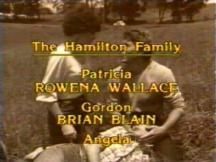
The theme music fades in - using what is known as
the 'Extended Version', with the lyrics 'Love can happen now and
it happened then' - the picture turns to sepia and the credits
begin to scroll up the screen, beginning with the cast and the
moving on to the crew. The same version of the music and style
of credits is also used at the end of Episode 4.
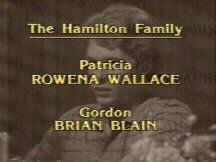
The end of the fifth episode sees a change in the
closing titles. The frozen picture stays, but there are changes
in the presentation of the credits and the music.
At the end of this episode, the cast credits no
longer scroll up the screen; instead, the names of two of the
characters and the actor/actress who plays them 'fade-up' for
a moment, then they 'fade-down' and the next two 'fade-up' and
so on. This procedure is followed for the cast names. After the
last of these, however, the production credits then scroll up
the screen as they did before. At this point, the cast is listed
in 'families' - i.e. 'The Hamilton Family' and 'The Palmer Family',
with separate slides for characters such as Fiona Thompson and
Jill Taylor who don't fit into that structure.
Episode 5 also sees the first use of the 'standard'
theme music at the end - that which begins, 'Love is very strange,
it can come and go'.
The next few episodes contain a mix of styles: the
all-scrolling credits return and appear to be becoming the norm,
but, from episode 15 onwards, things settle down to the style
first seen in episode 5.
The cast slides contain generally either two or
three names per slide - although some slides do manage to fit
four names on occasion.
The 'standard' version of the theme music is used
for most of the 1982 and 1983 seasons, with just the occasional
use of the 'extended' version. However, from the beginning of
the 1984 season, the 'extended' version is used at the end of
every episode - apart from at the end of the final episode (Episode
972), when the 'standard' version of the theme is played in its
entirety as the final credits scroll slowly over a montage
of photos from throughout the series.
Towards the end of the 1985 season, there's a slight
change to the style of the credits, as the 'family headings' are
changed to capitals. They then revert to title case at the start
of the 1986 season, but mix between upper case and title case
over the next few episodes.
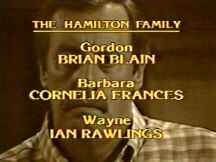
From episode 737, there's a major change to the credits: so few
characters are members of the main families at this stage that
the credits are changed to list the main cast in alphabetical
order. The guest stars follow, although curiously some are listed
in a smaller typeface than others (perhaps to signify which are
'major' guest stars and which aren't).
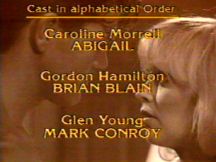
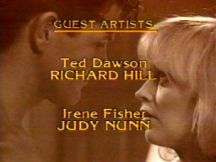
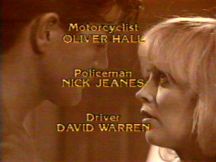
And there's another significant change from Episode 805 (mid-1986):
the episodes return to the all-scrolling format not seen since
the beginning of 1982. This style is retained right until the
final episode.

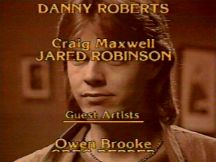
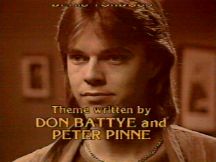
Style Anomalies in the UK
While the summary, above, outlines the standard
way in which Sons and Daughters' closing credits appeared,
there have been anomalies in the way the closing credits have
appeared in the UK.
The first five episodes of Sons and Daughters
broadcast on Channel 5 in the UK in 1998 used three different
versions of the theme music and three different styles of closing
credits. Comparing these with the endings shown for the same episodes
on UK Gold in 1992, it transpires that the episodes not only ended
in different places, but also in a different style! Below is a
brief look at the ways in which the early episodes of Sons
and Daughters ended on both Channel 5 and UK Gold.
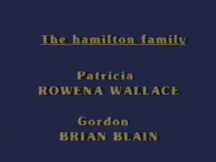 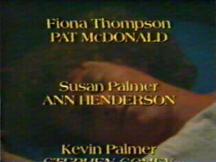
The first three Channel 5 episodes ended with virtually
no warning - there was a sudden cut from the action to the closing
titles (see screenshot, above left). There was also no introduction
to the music - it faded in just after the beginning of the vocals.
This appears to have happened because of the fact that the original
opening episode was 90 minutes long when it was shown in Australia,
but it was cut into three half-hour segments for screening in
the UK; these credits were therefore created specially.
The first three UK Gold episodes were actually more
'realistic' in the way they ended, insofar as the picture froze
and the credits started scrolling. The music also faded in properly.
The background during the credits for episodes 1 and 2 did not
turn sepia, but it did for episode 3 (as seen in the picture at
the top of this page).
These first three episodes all used
the 'extended' version of the theme tune. The Channel 5 episodes
contained a very poor-quality recording of the proper closing
music, but the UK Gold version sounded much clearer.
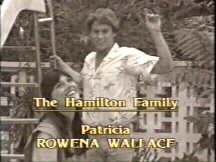
From episode four onwards, Channel 5 broadcast its
first appearance of the proper ending-style: the freeze and the
fade to sepia. The music began from its proper introduction and
was a better-quality recording.
Advertising Captions
The original tapes for Sons
and Daughters all contain two advertising captions towards
the end of the closing credits, after the name of the Executive
Producer and before the copyright information. However, ITV and
Channel 5 viewers in the UK have generally missed out on seeing
these, as they have been edited out before (or possibly even live,
during) broadcast, due to advertising regulations in this country.
The pictures below demonstrate how the adverts are supposed
to appear.
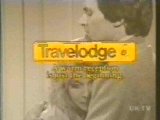
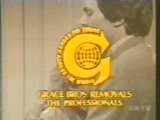
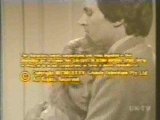
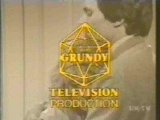
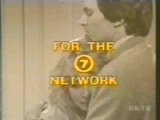
A large number of the episodes
shown on UK Gold did include these advertising captions,
though. The two screenshots below are taken from episode 4 as
it appeared on UK Gold:
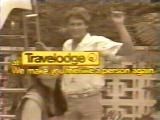
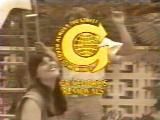
For the 7 Network
Through various corporate takeovers, Grundy Television
was bought in the 1990s by Pearson Television. Pearson was swallowed,
in turn, by Fremantle International. All ITV and UK Gold transmissions
included the 'For the 7 Network' caption at the very end of each
episode - as did Channel 5 during its run of the first 212 episodes
in 1998 and the first batch of episodes it aired following the
show's return in 2002. However, a few weeks into 2002, the 'For
the 7 Network' caption disappeared suddenly, and episodes cut
straight from the 'Grundy Television Production' caption to a
still 'Pearson Television International' caption:
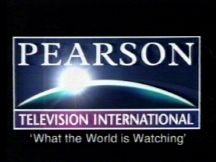
This only lasted about six weeks before it was replaced,
in turn, by a 'FremantleMedia' caption. This caption was retained
until the end of the series' run on (the by-then renamed) Five,
although the initial caption was replaced by an inverse animated
version.

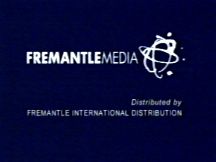
Quite why it was necessary to edit
out the 'For the 7 Network' caption in order to cut to the Pearson/Fremantle
captions is not clear, especially when the advertising captions
weren't shown, meaning there was no problem with the theme music
not extending for a long enough period to cover these additional
captions.
|

